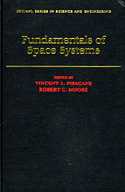|
772 pgs, 2005, Oxford University Press
ISBN 978-0195162059 This multidisciplinary book on space systems is intended for persons interested in understanding, planning, creating, and managing the design, fabrication, integration, and testing of space instruments and space systems. The reader is assumed to have an undergraduate degree in engineering or physics or the equivalent. Knowledge of calculus, vector analysis, differential equations, and classical and modern physics is assumed. The objective of this book is to provide an introduction to the development of space instrumentation and spacecraft systems and subsystems. This is accomplished by presenting the principles of systems engineering that are necessary to formulate the development process and the salient technical characteristics of the functional subsystems. The topics covered include the principles and applications of the following:
- Space systems engineering
- Near and deep space environments
- Astrodynamics
- Propulsion, flight mechanics, and launch systems
- Attitude determination and control
- Space power generation, conditioning, regulation, and distribution
- Thermal sources and techniques for thermal balance and protection
- Spacecraft configurations and structural design
- Up-link, down-link, and cross-link space communications
- Spacecraft command, control, and telemetry
- On-board data processing and storage
- Spacecraft reliability and quality assurance
- Subsystem tests, integration, and system-level tests
- Mission operations
Topics are covered to the depth that should allow the conceptual design of a space mission to be carried out by making the trade-offs necessary to satisfy a given set of needs or systems requirements. For the uninitiated or the more narrowly focused space specialist, this publication can serve to broaden the perspective and increase the breadth of knowledge of the reader. An understanding of the material should also permit the reader to carry out broader assignments and begin the transition to a career in systems engineering, technical leadership, or managing the development of space systems.
TABLE OF CONTENTS - Space Systems Engineering
- The Space Environment
- Astrodynamics
- Spacecraft Propulsion, Flight Mechanics, and Launch Systems
- Spacecraft Attitude Determination and Control
- Space Power Systems
- Spacecraft Thermal Control
- Spacecraft Configuration and Structural Design
- Space Communications
- Spacecraft Command and Telemetry
- Spacecraft Data Processing
- Spacecraft Reliability and Quality Assurance
- Spacecraft Integration and Test
- Mission Operations
Appendix: Useful Constants
|

